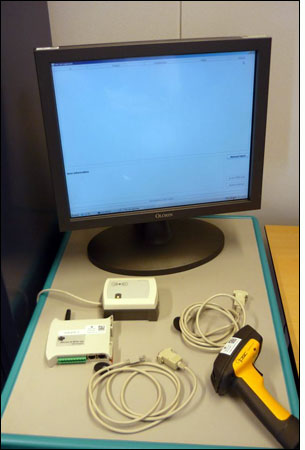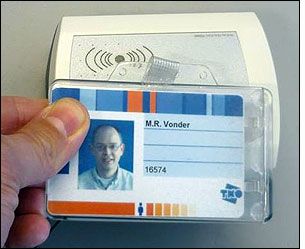TNO, a Netherlands research company based in Delft, serves as a “knowledge broker” for government agencies, small and midsize enterprises, and commercial businesses. The organization helps its clients to develop better products, and also provides recommendations regarding policy and processes. “We advise our customers, moreover, on finding the optimum solutions that are geared precisely to the questions they have,” says Matthijs Vonder, a TNO scientist and project manager.
To better track the movement of equipment it uses in that effort, TNO is employing a combination of RFID and bar-code technologies. The organization’s sensor lab has approximately 200 devices, comprising a variety of equipment heavily used in research, such as PDAs, RFID interrogators, ZigBee nodes, bar-code scanners, mobile phones, cables and AC/DC adapters. By implementing an RFID-based tracking system, the institute hoped to gain an understanding of which personnel utilized the equipment, how often they did so, where they were at any specific time, which assets were unnecessary and not being used, and which individuals have the experience to work with specific devices (in other words, who the previous users were).
“We wanted to develop a system in which all devices would be registered, and their data stored to track their usage and movement,” Vonder says. Management required a central location in which to store documentation and software, and it needed to be so easy that employees would be willing to use it.
TNO’s interest in RFID coincided with the development of TraSer, a three-year EU-funded project launched in 2006 to test Internet-based software, in order to enable European companies to share supply chain data. TNO was one of several European firms that tested RFID technology in conjunction with TraSer, an open-source platform that could be utilized by businesses to store and share information about items they wished to track—anything from closed-loop assets to products passing through supply chains. The TNO pilot with TraSer took place in 2008 and 2009, Vonder says, and then led to a full-scale RFID deployment in June 2009.
For its pilot and subsequent full-scale deployment, TNO affixed a high-frequency (HF) 13.56 MHz passive RFID tag, complying with the ISO 15693 standard, to each device or piece of equipment, and created a database containing information about those assets. The institute built an RFID “booth,” consisting of a desktop RFID interrogator (for reading the asset tags, as well as RFID-enabled employee identification cards) and a handheld bar-code scanner. Each asset or badge tag was encoded with an ID number that, for the sake of redundancy and flexibility, was also printed on the front of the tag in a human-readable format, as well as a 2-D bar code. The ID number was stored in TNO’s software.
Before using a tagged item, a worker would first place his or her ID card near the booth’s RFID reader, then place the item near the reader. A user seeking a specific piece of equipment could input the item’s ID number or description into the TraSer software in the database, and then view a description of which personnel recently checked that item out, and on which day. Staff members could continually add products to the system by reading a new tag or scanning a bar code, and then entering the item’s details into the TraSer Web-based software, running on one of TNO’s back-end servers.
Vonder says his company chose to work with HF 13.56 MHz RFID technology for two reasons: to ensure a short read distance in case multiple tagged items or ID badges were in the reader’s vicinity, and because the building-access ID cards already used by the staff contained an HF RFID inlay. Employees could then access data by logging on to the TraSer software and inputting the ID number or description of the item for which they searched. They were then presented with the history of which individuals had used that particular asset, and when.
The company was faced with one hardware problem, however—how to track RFID interrogators, including handhelds. “We had problems with labeling RFID readers with RFID tags,” Vonder explains. “The readers started reading their own label.” To work around this issue, TNO’s staff used only labels with 2-D bar codes and human-readable ID numbers on the readers. Information from the system could be utilized in a variety of ways, Vonder says. For one thing, it could indicate who had a particular piece of equipment, thereby reducing the time spent searching for those items. What’s more, it provided history that could be useful to the company. If a piece of equipment was going to require specific skills, for instance, an individual could look at the system and determine who had previously used that item, and was thus experienced in using it.
The TraSer platform was useful, Vonder says, but because TNO was utilizing a beta version of the software, the platform did not provide the performance the company required for a permanent deployment. Therefore, TNO switched to software that it developed in-house.
Throughout its three-year trial, TraSer’s platform was tested in 10 pilots, in Finland, Romania, the Netherlands and Hungary, according to Elisabeth Ilie-Zudor, the TraSer project’s coordinator, and a researcher at the Hungarian Academy of Sciences’ Computer and Automation Research Institute. Some of the pilots used RFID, she says, while others did not. Pilots ranged from in-house reusable equipment tagging to the tracking of goods in a supply chain across multiple collaborating partners. While some of the pilots were confined to a research environment, others targeted the logistics, health-care and food industries, as well as different branches of product design and manufacturing, such as automotive electrical components.
Five of the 10 pilots included the use of RFID. While some of the 10 pilots were dedicated field tests with a finite duration, three resulted in applications that continue today: TNO’s RFID-based equipment inventory system, a bar-code-based supply chain tracking service, and a tracking system for CAD files and other electronic documents. TraSer offers free downloads of the final version of its platform through the Web-based repository SourceForge.
“TraSer has generally proven itself well-suited for small-scale applications, especially due to its flexibility with regard to configuration, physical ID carriers and external interfaces,” Ilie-Zudor states. “Successful tests have revealed that TraSer puts a minimal burden on occasional participants of tracking processes, and is at the same time able to adapt to existing components of the enterprise IT infrastructure, such as ERP systems or peripheral middleware.”
Ilie-Zudor adds, “We believe that TraSer provides valuable help in lowering the burden of a company’s initial adoption… of tracking services.”
Since the TraSer project concluded, she adds, the “search for further exploitation is ongoing [by] several consortium members… we have already been contacted several times through our SourceForge site by potential users.”




